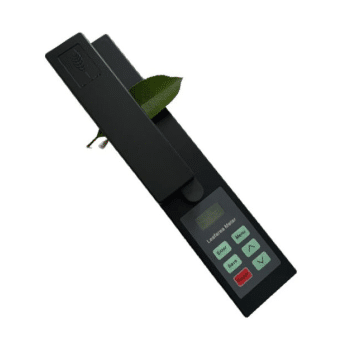A leaf area meter is a device used to measure the surface area of plant leaves. It provides a non-destructive and efficient way to assess the leaf area, which is an important parameter in various fields of plant science, including agriculture, forestry, ecology, and plant physiology.
Leaf area is a critical factor in understanding plant growth, photosynthesis, transpiration, nutrient uptake, and overall plant health. By accurately measuring leaf area, researchers and plant scientists can gather valuable data to study plant responses to environmental conditions, evaluate crop performance, monitor plant diseases, and assess the effectiveness of agricultural practices.
Leaf area meters typically consist of a measurement chamber or scanning area where the leaves are placed. The meter uses various techniques, such as image analysis or light transmission, to determine the leaf area based on the captured images or measurements. The specific method may vary depending on the model and manufacturer of the leaf area meter.
Here are some key features and capabilities commonly found in leaf area meters:
Leaf area meters are valuable tools for studying plants, providing quantitative data for research, agricultural management, and ecological studies. By accurately measuring leaf area, researchers can gain insights into plant physiology, growth patterns, and responses to environmental factors, ultimately contributing to improved crop production, ecosystem management, and scientific understanding of plants.
Features
Specifications
| Model No | SI - YMJ/A | |||
|---|---|---|---|---|
| Measuring range | Leaf area, average area, length of leaf, width of leaf, thickness of leaf, peri meter and ratio of length to width. | |||
| Test unit | Millimeter, square millimeter | |||
| Precision | +2% | |||
| Length | ≤1000mm | |||
| Width | ≤160mm | |||
| Stored datum | 200 Groups | |||
| Battery | 6V | |||
| Optional Accessories | Add RS-232 link with computer by software |


A leaf area meter is a device used to measure the surface area of plant leaves. It provides a non-destructive and efficient way to assess the leaf area, which is an important parameter in various fields of plant science, including agriculture, forestry, ecology, and plant physiology.
Leaf area is a critical factor in understanding plant growth, photosynthesis, transpiration, nutrient uptake, and overall plant health. By accurately measuring leaf area, researchers and plant scientists can gather valuable data to study plant responses to environmental conditions, evaluate crop performance, monitor plant diseases, and assess the effectiveness of agricultural practices.
Leaf area meters typically consist of a measurement chamber or scanning area where the leaves are placed. The meter uses various techniques, such as image analysis or light transmission, to determine the leaf area based on the captured images or measurements. The specific method may vary depending on the model and manufacturer of the leaf area meter.
Here are some key features and capabilities commonly found in leaf area meters:
Leaf area meters are valuable tools for studying plants, providing quantitative data for research, agricultural management, and ecological studies. By accurately measuring leaf area, researchers can gain insights into plant physiology, growth patterns, and responses to environmental factors, ultimately contributing to improved crop production, ecosystem management, and scientific understanding of plants.
Features:
Specifications
| Model No | SI - YMJ/A | |||
|---|---|---|---|---|
| Measuring range | Leaf area, average area, length of leaf, width of leaf, thickness of leaf, peri meter and ratio of length to width. | |||
| Test unit | Millimeter, square millimeter | |||
| Precision | +2% | |||
| Length | ≤1000mm | |||
| Width | ≤160mm | |||
| Stored datum | 200 Groups | |||
| Battery | 6V | |||
| Optional Accessories | Add RS-232 link with computer by software |

Samara Instruments is a trusted source for cutting-edge scientific equipment. We specialize in providing high-quality instruments and solutions for researchers, laboratories, and scientific professionals worldwide. With 8 years of industry experience, we are committed to delivering innovative products that empower scientific discovery and advancement.

A leaf area meter is a device used to measure the surface area of plant leaves. It provides a non-destructive and efficient way to assess the leaf area, which is an important parameter in various fields of plant science, including agriculture, forestry, ecology, and plant physiology.
Leaf area is a critical factor in understanding plant growth, photosynthesis, transpiration, nutrient uptake, and overall plant health. By accurately measuring leaf area, researchers and plant scientists can gather valuable data to study plant responses to environmental conditions, evaluate crop performance, monitor plant diseases, and assess the effectiveness of agricultural practices.
Leaf area meters typically consist of a measurement chamber or scanning area where the leaves are placed. The meter uses various techniques, such as image analysis or light transmission, to determine the leaf area based on the captured images or measurements. The specific method may vary depending on the model and manufacturer of the leaf area meter.
Here are some key features and capabilities commonly found in leaf area meters:
Leaf area meters are valuable tools for studying plants, providing quantitative data for research, agricultural management, and ecological studies. By accurately measuring leaf area, researchers can gain insights into plant physiology, growth patterns, and responses to environmental factors, ultimately contributing to improved crop production, ecosystem management, and scientific understanding of plants.
| Model No | SI - YMJ/A | |||
|---|---|---|---|---|
| Measuring range | Leaf area, average area, length of leaf, width of leaf, thickness of leaf, peri meter and ratio of length to width. | |||
| Test unit | Millimeter, square millimeter | |||
| Precision | +2% | |||
| Length | ≤1000mm | |||
| Width | ≤160mm | |||
| Stored datum | 200 Groups | |||
| Battery | 6V | |||
| Optional Accessories | Add RS-232 link with computer by software |